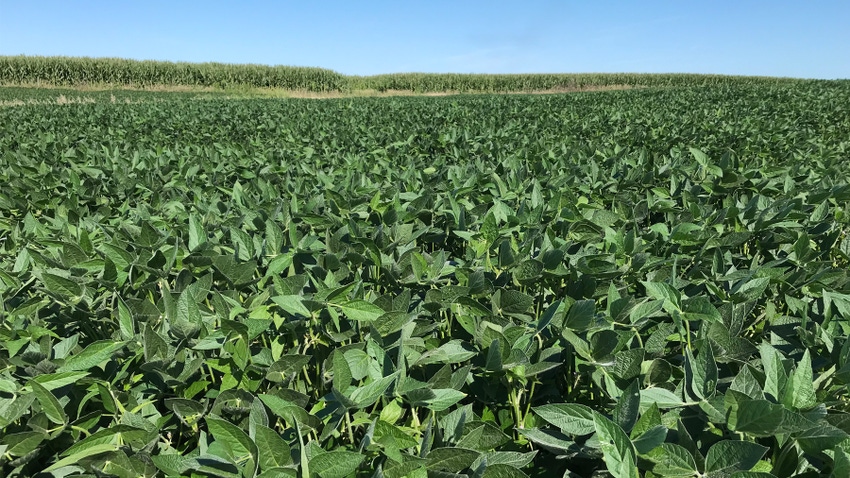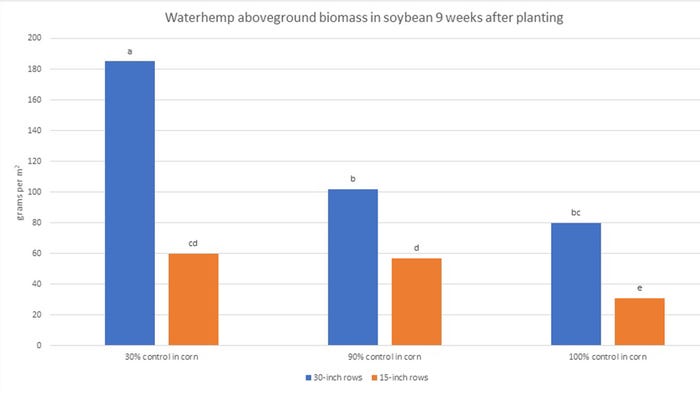October 4, 2023

Farmers across Iowa produce soybeans in a variety of row widths, but most soybeans are still planted in 30-inch rows. While 30-inch rows provide substantial flexibility in our corn-soybean rotations, narrow rows provide some advantages in the soybean year. This article will make the case for using narrower rows in soybean.
Farmers may face several challenges when adopting narrow-row spacing. They may be concerned about the need for new or additional equipment, running over soybean rows with field equipment, or the potential for increased threat of white mold. However, the advantages of narrow rows are increased yield potential and better suppression of weeds.

HERBICIDE EFFICACY RESEARCH: This graph shows the effect of the prior year’s corn herbicide efficacy and soybean row spacing on waterhemp aboveground biomass. (Yadav et al., 2023)
Using tram lines or controlled traffic patterns can reduce the concern regarding running over soybean rows. The pathogen responsible for white mold thrives in dense canopies that create an environment with high humidity and surface moisture. Moving to narrow rows increases the risk of white mold. However, we have several management options to mitigate the increased disease risk. We regularly choose soybean varieties for tolerance to numerous pathogens, and those using narrow rows can choose varieties that better tolerate white mold. Additionally, some foliar fungicides applied prior to pod setting are effective against this disease.
Weed management
One of the biggest challenges farmers face in any growing season is weed management, particularly waterhemp. Herbicides will likely remain the primary tool for waterhemp control, but we are losing efficacy of products every year. This summer, Bayer Crop Science reported the presence of two likely dicamba-resistant waterhemp populations in Iowa; we would be naive to think that dicamba resistance and 2,4-D resistance don’t already exist in numerous waterhemp populations across the state.
We need to make every reasonable effort to reduce waterhemp’s competitiveness with our crop and its ability to produce seed. Narrowing soybean rows from 30 inches to 15 inches or less is a cultural weed management tactic that reduces late-season waterhemp emergence, waterhemp competitiveness with the crop, and seed production. This occurs because waterhemp emergence and growth are heavily influenced by the availability of light, and narrow rows close canopy and reduce light penetration to the soil much earlier.
Recent research by Ramawatar Yadav at Iowa State University in 2019-20 showed the large benefit of narrowing soybean rows from 30 inches to 15 inches (Figure 1). The researchers placed treatments over areas that had poor waterhemp control (30%), good waterhemp control (90%), and zero-weed seed control (100%) the prior year in corn. All treatments had the same herbicide program in the soybean year. By nine weeks after planting, waterhemp densities were at least 13% lower in the narrow-row plots, and waterhemp aboveground biomass was reduced by more than 40% in 15-inch rows compared to 30-inch rows. This is just one of many studies that shows the complementary effect narrow rows can have with a strong herbicide program.
Other benefits
In addition to complementing herbicide programs to suppress weeds, narrow rows are beneficial for crop yield in many cases. The Science for Success series summarized research that revealed 69% of the time, narrow rows (7 to 15 inches) outyielded wider rows (30 inches or more). While this may not be a large yield advantage, data suggests a fairly consistent 1- to 4-bushel-per-acre advantage in narrow rows. The yield effect is often more obvious and consistent when soybeans are planted later, weeds have not been well managed in the past, or when soil moisture is limiting.
In summary, Iowa farmers should carefully evaluate the pros and cons of moving to narrower soybean rows. In a time where effective herbicide options for waterhemp are running out, narrow rows are a relatively easy cultural weed management option to reduce waterhemp competitiveness and seed production. In addition, this management strategy often results in a yield benefit to soybeans, and, over time, should be beneficial to the farm bottom line. Read more about narrow soybean rows and other soybean management strategies at soybeanresearchinfo.com/science-for-success.
Anderson is an Iowa State University Extension field agronomist.
About the Author(s)
You May Also Like






